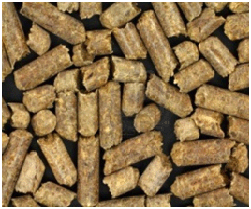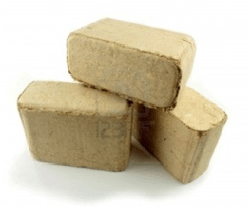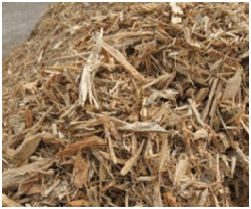Stoves and boilers
By clicking on a highlighted word, one is transferred directly to that part of this chapter dealing with that subject or to another page on this homepage, which describes that subject in more detail.
The illustrations are chosen at random and do not convey any endorsement of the product they depict.
General
This chapter outlines the general principles of the use of wood as a fuel in household and commercial appliances. Household application range is up to 100 kW output, while commercial installations range up to 500 kW. Industrial appliances start at 500 kW and the sky is the limit. For more detailed information on appliances as such please visit www.seai.ie.
In most cases a wood consuming heating system consists of several main parts:
• Fuel storage
• Fuel handling system
• Conversion appliance
• Ash handling system
These parts will be discussed in separate chapters.
There are two main principles for converting fuel into energy: burning and gasification. These are outlined here.
Choosing the right size of the boiler is very important therefore advice is given on how to choose the adequate size of the installation.
Not every fuel is suited for every boiler and local circumstances may dictate what fuel to use. Therefore advice is given below on what fuel to use where.
However before dealing with all the technicalities of appliances, knowledge of which wood fuels exist and their general specifications is very useful.
Wood fuels
In general one can divide wood fuels into several broad categories:
• Firewood
• Wood chips
• Wood pellets
• Wood briquettes
• Hog fuel
For an illustration see Figure 1
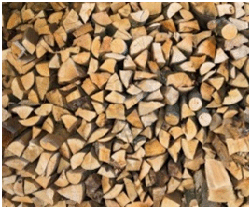
Firewood
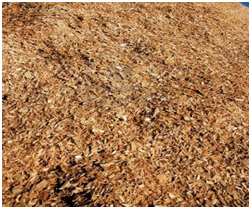
Woodchips
Woodpellets
Wood briquettes
Hog fuel
Figure 1 Wood fuels: firewood (a), wood chip (b), wood pellets (c), briquettes (d) and hogfuel (e) – images not to scale.
For firewood and wood chips, the main properties of importance are the moisture content, the nominal size of the particles and their size distribution, and for wood pellets and briquettes, the durability and amount of fines.
The easiest way to avoid fuel problems is to look for suppliers that are members of the Wood Fuel Quality Assurance scheme or WFQA (www.wfqa.org ). Look for this logo as shown in Figure 2.
Figure 2.
The WFQA applies the fuel requirements outlined in the EN ISO standard 17225 parts 1 to 9 and checks that the suppliers in the scheme maintain that quality by taking samples which are tested at an independent laboratory. Suppliers also have to monitor and document the quality of their fuels themselves by frequent sampling and testing. There are similar schemes running in other countries, such as DINplus and ENplus, so fuels that come with those logos are also certified as being of good quality.
Moisture content
Wood fuels can be divided into four main groups according to moisture content:
Very dry fuels (moisture content less than 10%):
• wood pellets
• wood briquettes
Dry fuels (moisture content over 10 and below 20%)
• firewood
• dry wood chips
• hogfuel (crushed wood, not for household appliances)
Wet fuels (moisture content over 20 and below 30%)
• wood chips
• hogfuel (crushed wood, not for household appliances)
Very wet fuels (moisture content over 30 and below 60%)
• fresh wood chips
• hogfuel (crushed wood, not for household appliances)
In general the drier the fuel, the more expensive it is, as it will provide more heat per unit weight or volume than wet fuel. For this reason, payment according to the energy value of the fuel - per Giga Joule (GJ) or Mega Watt hour (MWh) - is the most transparent way to go. For firewood and woodchip in particular the fuel should be sold at specified moisture content and by weight. Since wood pellets and briquettes have a fairly standardized moisture content, they can be traded by weight only.
The moisture content of wood fuels is expressed as a percentage of total weight as received. The moisture content is determined by drying a sample in a drying cabinet at 103 degrees C for at least 24 hours or until constant weight has been achieved. By dividing the weight loss by the total weight before drying and multiplying the result by 100, one gets the moisture content in percent.
For ease of use, the moisture content of biofuels is often expressed in M classes in the European standards with intervals of 5%. If for example a fuel belongs to moisture class M35, it means that the fuel contains between 30 and 35% moisture. A sample can belong to one only class.
Nominal size and size distribution
Not only the moisture content of fuels is important, but also the size distribution of the wood chip particles. For wood pellets and briquettes it is important that the amount of fines in the fuel is kept very low. Also the variation is size between the pellets should be small, and overlong pellets should be avoided. In firewood the length of the pieces and the amount of splitting are important as these influence moisture content and flammability.
For wood chip the size distribution and also the actual nominal size of the chips are very important. Wood chips are cut with sharp tools (such as knives) and have a more or less regular shape. The nominal size is the cutting length of the particles to which the chipper has been adjusted. In the size distribution it is important to know how much fines the fuel contains, as well as how many percent of oversize particles there are. Fines can cause problems because they are lifted from the fuel by the air that is blown into the boiler and tend to whirl up into the heat exchange tubes or the flue gas filtering system, which may become clogged. Oversize particles can cause fuel feeding problems because the fuel bridges-over openings and thus prevents the fuel from flowing from the hopper to the boiler.
It is obvious that the size of wood chips should be adapted to the size of the boiler. Small boilers need small chips, while very large boilers can handle very large chips.
In the EN ISO 17225 the size of the chips is expressed in P-classes.
The following classes are relevant for the boilers in this chapter:
• P16 small chips
• P31 medium chips
• P45 large chips
• P63 very large chips.
In these classes, the number indicates the screen size through which 70% of all particles have to fall to belong to that class. Of course there are many other requirements which can be found in the relevant EN/ISO standards.
Also for firewood several classes exist in the European standard , which are determined by the length and also the amount of splitting.
The same classes as for wood chips are also valid for hogfuel (broken or crushed wood particles), but hogfuel is hardly a fuel for small or medium boilers. The material is very flossy and sticks together making it a difficult fuel to handle. The particles vary much in size and shape. As such it is more a fuel for industrial size installations.
Durability of wood pellets and briquettes
Wood pellets and briquettes are made by compressing ground wood particles together under application of heat and high pressure. The lignin in the wood becomes plastic and bonds the particles together without having to use any glue. The intensity of the compression decides the durability of the wood pellets and briquettes.
During handling, pellets and briquettes undergo a lot of wear and tear and if the durability of the particles is not high enough, fines will occur in the fuel. Since fines burn much faster than whole pellets, they can cause problems in the boiler, but also in the hopper, where they prevent the pellets from sliding down to the feeding auger.
The European Standard as well as the coming ISO standard requires a durability of at least 97.5%, meaning that this percentage of pellets has to survive a tumbling test of 15 minutes duration as whole pellets.
Fines in wood pellets
Fines in wood pellets can cause several problems, such as excessive dust in the air during handling, accumulation at the bottom of the hopper thus preventing the pellets from sliding down to the feeding auger and finally in the boiler, where they burn much hotter than wood pellets. Such high temperatures may cause the ash to sinter or fuse, which then causes problems during the removal of the ash from the boiler.
The European Standard as well as the coming ISO standard require wood pellets to contain a maximum of 1% of fines at the last point of loading, meaning at the factory gate or when the pellets leave the gate of the seller. This is valid for both pellets in bulk volume, as well as pellets in bags, be they large of small.
Influence of tree species
It is commonly assumed that hardwoods, such as beech, oak, ash and birch have a higher heating value than softwoods such as spruce, larch and pine. This may be true if one looks at the volume, but it is false if one looks at the weight at the same moisture content. It is a fact that one has to put fewer hardwood logs on the fire than pieces of softwood, but that is when measured by volume. If one would weigh the hardwood logs and the softwood logs, the amount of fuel used would be more or less the same for the same amount of energy produced. The reason is that hardwoods are denser than softwoods, meaning that there is more dry matter per unit of volume than softwood.
However the amount of fuel one uses is determined by the weight and the moisture content, not the volume. By unit of weight at the same moisture content, softwoods have in fact a slightly higher energetic value than hardwoods, because they contain resins that have a very high energy value.
This than is another good reason why one should buy firewood and wood chips by the tonne and at specified moisture content, because then one knows how much potential energy one is getting.
Price of wood fuels
The price of wood fuels is difficult to specify since the quality requirements, the location and the amount to be delivered vary from boiler to boiler. Therefore always ask several suppliers for a quote with a clear specification of what is to be included in the price.
A general remark: there is no such thing as a cheap high quality fuel. If a fuel is cheap there may be something which is not as it should be. Either the moisture content is too high (especially firewood and wood chips), the size specification is wrong (wood chips with oversize particles, or wood chip or pellets which contain too many fines) or the fuel contains material which should not be there (sand and stones in wood chip, recycled timber in wood pellets). For wood pellets there are some easy ways to check the quality.
In all cases and as stated before look for quality marks such as the WFQA as stated before.
Buying wood fuel is also largely a matter of trust. One should be able to trust the supplier to come with the right fuel at the right time for one’s specific boiler.
In case of serious problems one can contact Waterford Institute of Technology (Tom Kent) where there is a wood fuel laboratory. However the cost of analysing a sample is considerable and therefore one should only contact WIT for really serious problems that can lead to legal proceedings.
Conversion methods
In general there are two main conversion methods that turn solid fuel into useable energy:
- burning with excess air
- gasification with an air deficit.
In the burning process excess air is added, so that fuel is converted from the carbon-hydrates to carbon dioxide (CO2), water, energy and very low amounts of other gasses and substances (like ash). The flue gasses still contain a surplus of oxygen, the carbon dioxide, water vapour and the other gasses, as well as a tiny amount of fine dust.
In the gasification process, the air supply is deliberately kept low. By heating the fuel, the volatiles are transformed to carbon-monoxide (CO), hydrogen gas (H2) and often a spectrum of tars and other poly- aromatic hydrates, the so called PAHs. Both the tars and the PAHs can be detrimental to health. The gasses are later burned with excess air if one wants to produce heat or can, after rigorous cleaning, be used as a fuel in piston engines, and power a generator to produce electricity. The cooling of the engine and the generator can be used to heat water for a district heating system.
In order for a fuel to burn in an appliance, the first thing that has to happen is the evaporation of the moisture in the fuel (everyone knows that water does not burn). Evaporation requires energy from the fuel itself and this limits the amount of useful energy that can be taken from the appliance. It is thus clear that the amount of useful energy one can take out of a boiler that runs on a very dry fuel like wood pellets is much higher than from a similar boiler that runs on wood chips, with say 50% moisture content. For most domestic appliances though, wood chip needs to be at a moisture content below 30% for the appliance to work satisfactorily. The drying of the fuel is aided by the primary air that is blown through the fuel layer. After drying, the volatiles in the wood are driven off (wood contains almost 85% volatiles!). These gasses burn above the fuel layer, aided by the secondary air that is blown into the burning chamber. After the volatiles are removed, the remaining charcoal burns out and that leaves ashes. They consist mainly of the nutrients the trees have absorbed over their lifetime as well as sand and dirt that have accumulated during the harvesting and production process. The whole process is illustrated in Figure 3.
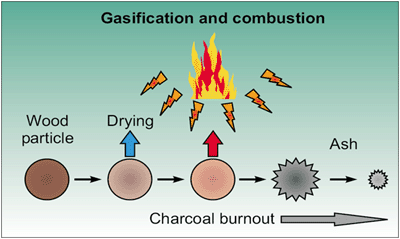
Figure 3 Burning process
In fact, most boilers are constructed with a specific fuel in mind: boilers that are specifically built to burn wood pellets usually cannot burn dry wood chips and certainly not wet fuels. On the other hand, a boiler which has been designed to handle wet fuels can have problems in dealing with very dry fuels. Wet fuel boilers usually have a ceramic lining, which absorbs first the heat from the burning process and then radiates it onto the fuel to assist in the drying. If too dry a fuel is used in these boilers, the brick lining gets too hot and might crack, so therefore stick to the moisture limits (both under and upper limit) of a boiler.
As pointed out, for domestic use, in almost all cases only dry fuels are suitable. For larger installations however one should consider using wet fuels, even though such a boiler might be more expensive than one that runs on a drier fuel. This is because dry fuels tend to be more expensive and more difficult to obtain.
In large boilers it is possible to recover the evaporation heat of the water in the fuel by cooling the flue gasses with the returning water of the (district) heating system. Normally flue gasses leave the chimney at a temperature well above 100 degrees C, but if these gasses are cooled to below 65 degrees C, then the moisture in the flue gasses condenses and releases the energy that was used to evaporate it. The condensate must be purified of the fine dust it washes out from the flue gas, before it is released into the waste water system. Another advantage of these so-called condensing boilers is that the flue gasses have a very low content of fine dust on leaving the chimney.
General remarks on wood burning appliances:
As stated in the opening remarks of this chapter a wood consuming heating system consists of four main parts:
- fuel storage
- fuel handling
- conversion appliance
- ash handling system
Each of these parts is discussed in the appropriate sub chapters.

